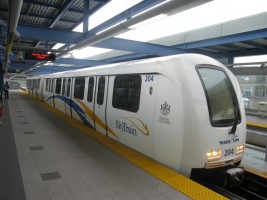 Metro-Cammell Glasgow Underground Stock 118
Metro-Cammell Glasgow Underground Stock 118
Location: Cowcaddens Station, Glasgow, Scotland
Operator of Vehicle: Strathclyde Partnership for Transport
Date of Photo: August 2, 2005
A recent video by railfan and videographer extraordinaire Geoff Marshall about the new Glasgow Subway rolling stock caught my attention. The third generation of rolling stock for this unique subway system is in the process of being introduced, which means that the second generation stock that has been in service since 1980 will be retired soon. This second generation stock is what I rode when I visited Glasgow for a day in the summer of 2005, so it seemed fitting to feature the outgoing rolling stock as a Photo of the Month.
The Glasgow Subway opened on December 14, 1896, making it the third oldest subway in Europe (only London and Budapest are older). However, it does have the distinction of being the first mass transit system in the world to be known as a subway. The trains have an uncommon gauge of 4 feet, making the trains narrower than those on the deep level tube lines of the London Underground. The Glasgow Subway also has the distinction of having never been expanded since it opened, it serves the exact same 15 stations and 6.5 miles (10.5 kilometers) of track that it has been serving for over 127 since opening.
With the arrival of the third generation rolling stock, it is expected that the second generation stock will be phased out over the course of 2024. The third generation of stock is designed to be converted to driverless operation and will have full front views for passengers, just like the Docklands Light Railway, once “ZPTO” begins. There are also plans to install platform screen doors in conjunction with the transition to driverless operation. Geoff Marshall covers these topics and more in his video, which can be seen here.
Have you been on the Glasgow Subway?
For more photos of the Glasgow Subway, please click here.
 1973 Stock 126
1973 Stock 126 Routemaster
Routemaster


